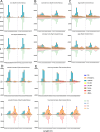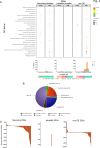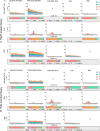Small non-coding RNAs have predicted roles in reproductive biology and transposable element regulation in the parasitic worm Strongyloides venezuelensis
- PMID: 40593876
- PMCID: PMC12215018
- DOI: 10.1038/s41598-025-01968-2
Small non-coding RNAs have predicted roles in reproductive biology and transposable element regulation in the parasitic worm Strongyloides venezuelensis
Abstract
The gastrointestinal parasitic nematode Strongyloides spp. has a unique life cycle that alternates between a parasitic generation that reproduces through mitotic parthenogenesis and a dioecious free-living sexually reproducing generation. Adult females from these two generations are genetically identical, making them an informative model to identify molecular differences between parasitic and free-living lifestyles and understand different reproductive strategies. We investigated the expression of small RNAs (sRNAs) that are either enriched for a 5' monophosphate modification (5'pN) or are 5' modification-independent, across five life cycle stages of the rodent parasite Strongyloides venezuelensis. We identified miRNAs and small-interfering RNAs expressed by S. venezuelensis that are predicted to target and regulate the expression of protein-coding genes and transposable elements (TEs). Three previously unreported classes of sRNA were identified: (1) 25Gs with a putative role in reproduction in adult females, (2) tRNA-derived 24-28 nt sRNAs (tsRNAs) which are predicted to target TEs in free-living females, and (3) 5'pN-enriched 26-29Cs with 5' CGAATCC and 3' TTT motifs expressed in parasitic females. We also confirmed that S. venezuelensis expresses the 27G class of sRNAs involved in TE regulation, which was previously identified in the rodent parasite Strongyloides ratti. Taken together, these results provide new insights into the role of sRNAs in reproductive biology and parasitism.
Keywords: Strongyloides venezuelensis; Helminth; Nematode; Parasite; Small RNA; microRNA.
© 2025. The Author(s).
Conflict of interest statement
Declarations. Competing interests: The authors declare no competing interests.
Figures








Similar articles
-
The generation of stable transgenic lines in the human-infective nematode Strongyloides stercoralis.G3 (Bethesda). 2024 Aug 7;14(8):jkae122. doi: 10.1093/g3journal/jkae122. G3 (Bethesda). 2024. PMID: 38839055 Free PMC article.
-
Karyotype and reproduction mode of the rodent parasite Strongyloides venezuelensis.Parasitology. 2014 Nov;141(13):1736-45. doi: 10.1017/S0031182014001036. Epub 2014 Aug 4. Parasitology. 2014. PMID: 25089654 Free PMC article.
-
Systemic pharmacological treatments for chronic plaque psoriasis: a network meta-analysis.Cochrane Database Syst Rev. 2021 Apr 19;4(4):CD011535. doi: 10.1002/14651858.CD011535.pub4. Cochrane Database Syst Rev. 2021. Update in: Cochrane Database Syst Rev. 2022 May 23;5:CD011535. doi: 10.1002/14651858.CD011535.pub5. PMID: 33871055 Free PMC article. Updated.
-
Systemic pharmacological treatments for chronic plaque psoriasis: a network meta-analysis.Cochrane Database Syst Rev. 2017 Dec 22;12(12):CD011535. doi: 10.1002/14651858.CD011535.pub2. Cochrane Database Syst Rev. 2017. Update in: Cochrane Database Syst Rev. 2020 Jan 9;1:CD011535. doi: 10.1002/14651858.CD011535.pub3. PMID: 29271481 Free PMC article. Updated.
-
Dynamic shifts in isomiR profiles during parasite maturation of Fasciola hepatica.RNA Biol. 2025 Dec;22(1):1-22. doi: 10.1080/15476286.2025.2538271. Epub 2025 Jul 31. RNA Biol. 2025. PMID: 40745916 Free PMC article.
References
-
- World Health Organization. 2030 Targets for Soil-Transmitted Helminthiases Control Programmes (World Health Organization, 2020).
-
- Viney, M. E. A genetic analysis of reproduction in Strongyloides ratti. Parasitology109, 511–515 (1994). - PubMed
MeSH terms
Substances
Grants and funding
LinkOut - more resources
Full Text Sources
Research Materials
Miscellaneous

